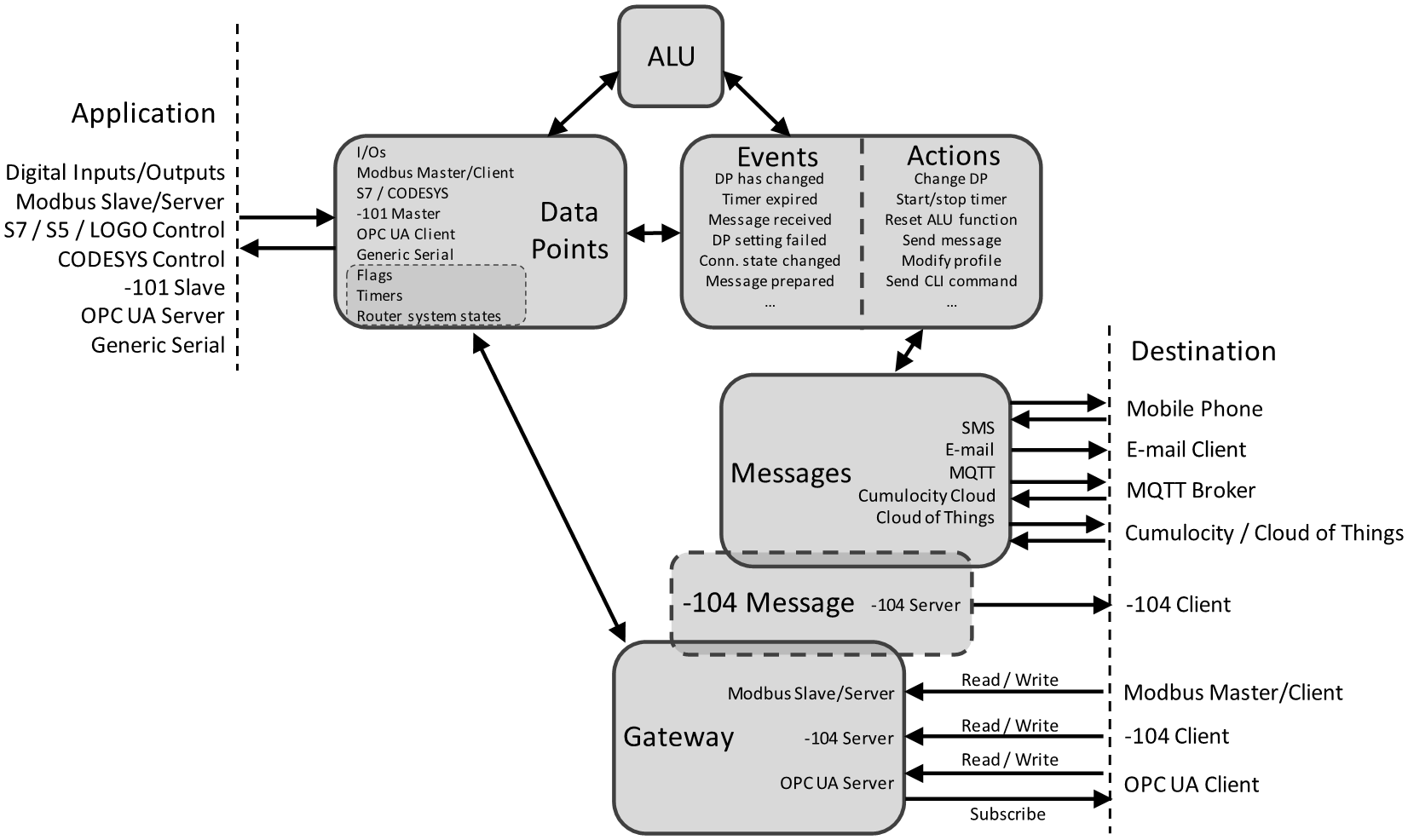 |
Online Help icom Data Suite |
Operational and Functional Principle
The central elements of the icom Data Suite are data points. Data points are, amongst others, generated in the icom Data Suite by reading out connected devices of the application or mapping the inputs or outputs of the router. These data points can be combined or evaluated in the icom Data Suite using logic or arithmetic functions. Data points are monitored and trigger events that again trigger actions assigned to it. Actions can change data points or dispatch messages. Messages can be sent to connected instances via a variety of channels and protocols. Gateways allow to provide data points for connected instances. Instances may include devices, servers, cloud services or control centers for example.
Recurring configuration elements
Some elements are available on many configuration pages and share a similar function.
The Name of a data point, function or other element will be generated automatically in the order of creation. It remains unchanged until the data point, function or element will be deleted.
The checkbox active allows to deactivate or activate again a data point, function or other element.
The user can enter the respective function of a data point, function or other element as Description for a clear differentiation.
A series of symbol buttons enables to execute different operations with one click.
Preparing a configuration for an application
The data points necessary for the application will be configured first. If a message is to be dispatched in an action, the message must be configured first. A configuration is set up in a profile.
Data points
Data points can be:
- Inputs and outputs of the router (I/Os)
- Read values of connected Modbus devices
- Read values of connected Siemens S7, S5 and LOGO controls
- Read values of connected CODESYS controls
- Read values of connected devices in IEC 60870-5-101 or OPC UA networks
- Internal flags
- Internal timers
- System status values of the router
- Results of the Arithmetic Logic Unit (ALU)
- Read values of a generic serial interface
Necessary I/Os, flags, timers or system status values of the router will be configured directly.
The data logger of the icom Data Suite permits periodic and event-triggered writing of selected data points into a database (datalog). The content of the datalogs can be exported individually into CSV files, which can either be dispatched or downloaded in the icom Data Suite.
ALU functions
If necessary, data points can be combined or evaluated using the Arithmetic Logic Unit (ALU). The operations are available again as data points.
- Logic (Boolean) operation of the data points
- Combination of a data point with another or a fix value using one of the four basic arithmetic operations (addition, subtraction, multiplication, division)
- Determination of a minimum, maximum or average value of one or more data points over current values or time
Events and actions
Various events can trigger actions assigned when they occur. In order to trigger the dispatch of a message, this must be configured before. The following event are available for this amongst others:
- Data point has exceeded or fallen below a limit or has changed
- Timer has expired
- Message has been received (with evaluation of the message content)
- Device has been read
- Connection status has changed
- Setting of a data point has failed
- Application has been started
- Message has been prepared for dispatch
- Set a data point
- Start or stop a timer
- Reset an ALU function
- Send message
- Activate profile
- Apply ASCII configuration
- Start Lua script
- Restart router
- Send CLI command to router
Messages
Messages can be sent within the scope of an action via SMS, e-mail or MQTT to specified recipients as well as to the Cumulocity Cloud or Telekom Cloud of Things in form of server feeds.
The current values of data points can be transmitted within the messages.
The evaluation of the receipt of a message can be configured within the scope of an event.
The message content can be interpreted to change data points or trigger further asctions for example.
Note: Messages as per the IEC 60870-5-104 protocol are configured in the associated gateway.
Gateway
The icom Data Suite can also act as gateway and provide the values of all data points to other connected devices or higher-level systems. The following networks are supported with this:
- Modbus (function as Modbus slave/server)
- IEC 60870-5-104 (function as 104 server)
- OPC Unified Architecture (function as OPC UA server)
User interfaces
Besides the web interface, a REST interface and a command line interface (CLI) are available.
